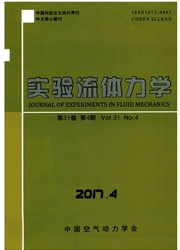

 中文摘要:
中文摘要:
对具有叶顶间隙的直叶栅和正、反弯三套涡轮叶栅进行了实验测量,研究在较大间隙(0.036)下,气流冲角和叶片弯曲对叶顶泄漏流动的影响。根据壁面流动的墨迹显示,应用拓扑学原理,分析了叶片表面和上、下端壁的拓扑结构,指出当气流冲角由0°增至20°时,与零冲角下的同类叶栅相比较,鞍点的位置均移向上游,分离区的范围在沿流向和垂直流向的方向上扩大,上、下通道涡分离线向叶展中部爬升。在冲角为零以及20°的情况下,叶片正弯均消除了上通道涡,这一方面减少了壁面流场中奇点和分离线的数量,较大地降低了上通道涡与泄漏涡的相互作用损失,另一方面强化了端壁横流对泄漏流动的封堵作用,有利于降低相对漏气量。
 英文摘要:
英文摘要:
The experimental measurement was performed with three sets of conventional straight, positively curved and negatively curved turbine cascades with tip clearance, and the effect of flow incidence angle and blade bending on top leakage was studied under larger clearance of 0. 036. By means of the ink trace visualization of the wall flow and the topology theory, the to- pological structures of the blade surface, the upper and lower end-wall were analyzed. It is pointed out that, compared with the same cascade under zero incidence angle, the saddle points all move to the upstream, the scope of the separation expands along the flowing direction and the vertical flow direction, and the separation line of upper and lower passage vortex climbs to the mid-span of the blade when the flow incidence angle increases from zero to 20°. This paper points out that under the conditions of zero and 20° incidences, blade positively curving eliminates the upper passage vortex, which on the one hand deereases the numbers of the singular points and the separation line within the wall flow field, reduces the interaction loss between the passage vortex and the leakage vortex greatly, and on the other hand strengthens the blocking effect of the end wall cross flow on the leakage flow, thereby reducing the relative leakage.
 同期刊论文项目
同期刊论文项目
 同项目期刊论文
同项目期刊论文
 patial discretization error in an artificial benchmark model of oblique laser incidence by finite vo
patial discretization error in an artificial benchmark model of oblique laser incidence by finite vo Analysis on capabilities of density-based solvers within Open FOAM to distinguish aerothermal variab
Analysis on capabilities of density-based solvers within Open FOAM to distinguish aerothermal variab A Second Order Radiative Transfer Equation and Its Solution by Meshless Method with Application to S
A Second Order Radiative Transfer Equation and Its Solution by Meshless Method with Application to S Analysis on transient conjugate heat transfer in gap–cavity–gap structure heated by high speed airfl
Analysis on transient conjugate heat transfer in gap–cavity–gap structure heated by high speed airfl Numerical simulation of infrared signature emitted by liquid rocket plume using wide band k-distribu
Numerical simulation of infrared signature emitted by liquid rocket plume using wide band k-distribu Effect of air temperature on combustion characteristics and NOx emissions from a 0.5 MW pulverized c
Effect of air temperature on combustion characteristics and NOx emissions from a 0.5 MW pulverized c Experimental study of the impact of holes-typesuction on the flow characteristics in a high-load com
Experimental study of the impact of holes-typesuction on the flow characteristics in a high-load com First-principles molecular dynamics study on temperature-dependent dielectric function of bulk 3C an
First-principles molecular dynamics study on temperature-dependent dielectric function of bulk 3C an Temperature-dependent dielectric function of germanium in the UV-vis spectral range: A first-princip
Temperature-dependent dielectric function of germanium in the UV-vis spectral range: A first-princip Characterization of combustion and NOx emissions with respect to over-fire air damper opening in a d
Characterization of combustion and NOx emissions with respect to over-fire air damper opening in a d Simulation of flow behavior of particles bycluster structure-dependent drag coefficient model for ch
Simulation of flow behavior of particles bycluster structure-dependent drag coefficient model for ch An effective inversion algorithm for retrieving bimodal aerosol particle size distribution from spec
An effective inversion algorithm for retrieving bimodal aerosol particle size distribution from spec Study of topology and vortex structure in turbinecascades with tip clearance under differentincidenc
Study of topology and vortex structure in turbinecascades with tip clearance under differentincidenc Effect of the anthracite ratio of blended coals on the combustion and NOx emission characteristics o
Effect of the anthracite ratio of blended coals on the combustion and NOx emission characteristics o Experimental study on the characteristics of heat transfer and flow resistance in a turbulent pipe f
Experimental study on the characteristics of heat transfer and flow resistance in a turbulent pipe f Evaluation on cold modeling flow field for a down-fired 600 MWe supercritical boiler with multi-inje
Evaluation on cold modeling flow field for a down-fired 600 MWe supercritical boiler with multi-inje Modeling of a rotational supercavitating evaporator and geometrical characteristics of supercavity i
Modeling of a rotational supercavitating evaporator and geometrical characteristics of supercavity i Annaland Martin van Sint.Hans Kuipers, Dongsheng Wen, Discrete particle modeling of granular tempera
Annaland Martin van Sint.Hans Kuipers, Dongsheng Wen, Discrete particle modeling of granular tempera A de?ciency problem of the least squares ?nite element method for solving radiative transfer in stro
A de?ciency problem of the least squares ?nite element method for solving radiative transfer in stro Simulation of flow behavior of particles by cluster structure-dependent drag coefficient model for c
Simulation of flow behavior of particles by cluster structure-dependent drag coefficient model for c Aerodynamic characteristics within a cold small-scale model for a down-fired 350 MWe supercritical u
Aerodynamic characteristics within a cold small-scale model for a down-fired 350 MWe supercritical u Numerical simulation of natural convection in a square enclosure filled with nanofluid using the two
Numerical simulation of natural convection in a square enclosure filled with nanofluid using the two Inner and Outer Secondary-Air Distance-Effect Study within a Cold Small-Scale Model of a New Down-Fi
Inner and Outer Secondary-Air Distance-Effect Study within a Cold Small-Scale Model of a New Down-Fi New over-fire air arrangement and its air ratio optimization determined by aerodynamic characteristi
New over-fire air arrangement and its air ratio optimization determined by aerodynamic characteristi 期刊信息
期刊信息
